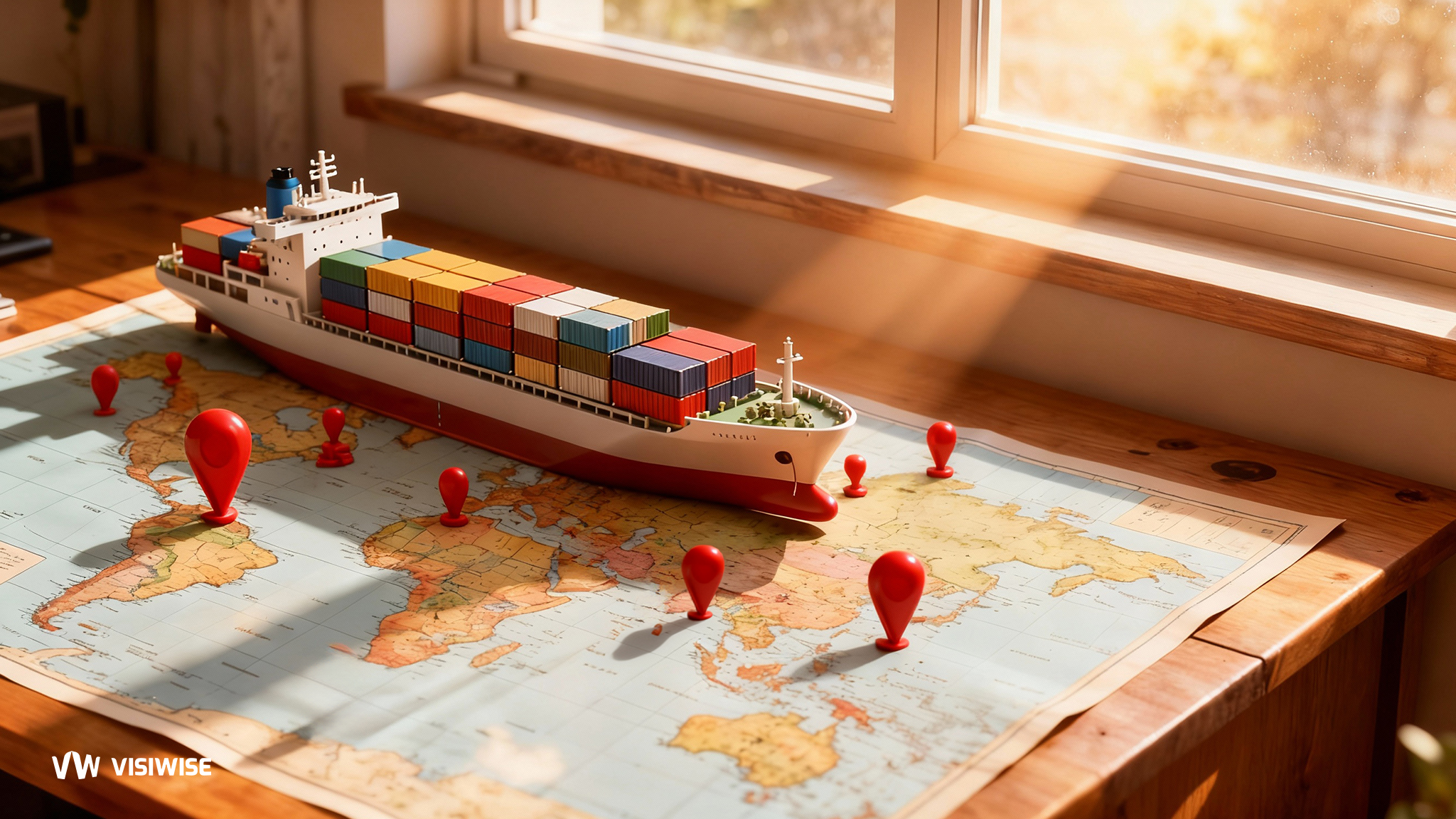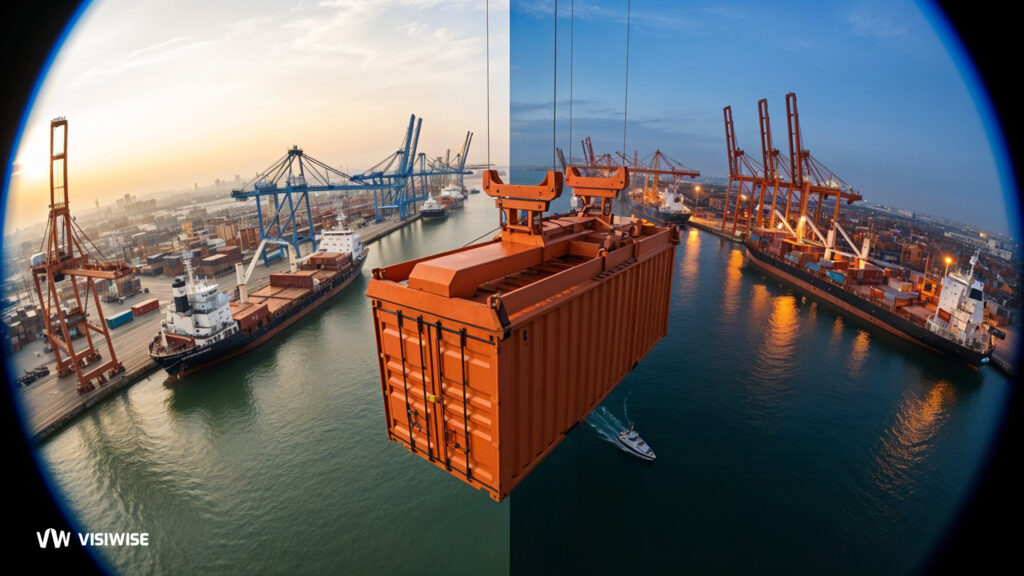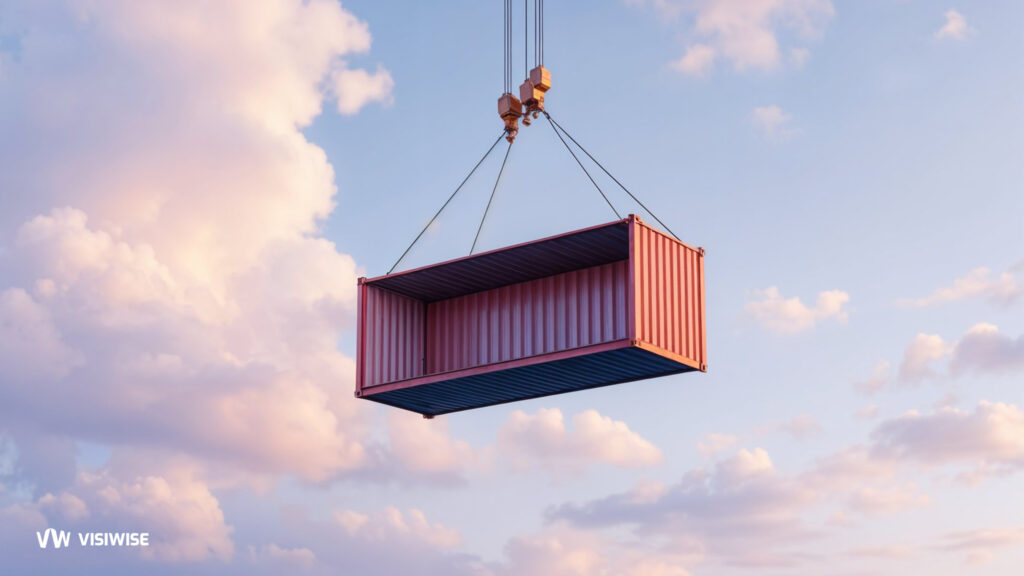As we discussed in our latest blogpost, Transshipment is one of the key pieces of the logistics puzzle. In this one, we explore the 2024-2025 top busiest Transshipment Hubs in the world, and break down the most important facts about each port.
2024–2025 Top 10 Transshipment Hubs: Quick Stats
| Rank | Port (2024 name) | Country / Region | 2024 Throughput (TEUs, in millions) |
| 1 | Port of Shanghai | China | 51.506 |
| 2 | Port of Singapore | Singapore | 41.124 |
| 3 | Port of Ningbo–Zhoushan | China | 39.308 |
| 4 | Port of Shenzhen | China | 33.380 |
| 5 | Port of Qingdao | China | 30.870 |
| 6 | Port of Guangzhou (Nansha) | China | 26.070 |
| 7 | Port of Busan | South Korea | 24.402 |
| 8 | Port of Tianjin | China | 23.290 |
| 9 | Jebel Ali (Dubai) | United Arab Emirates | 15.536 |
| 10 | Port Klang | Malaysia | 14.645 |
Port of Shanghai
The Port of Shanghai is also called SIGP (code CN SGH), as it is operated by the Shanghai International Port (Group). The company provides various port-related services for worldwide consumers.
The Port of Shanghai is the largest seaport in the world, which was put into service in 1842. Over the years, the place has grown to become one of the most important ports in the region. The port occupies an area of almost 4 km2.
The port is linked with the Yangtse River, reaching into multiple provinces of China. Thanks to the extensive access to Chinese seas and the oceans of the world, the port has become an important transport hub. It is undoubtedly one of the most important Chinese gateways for foreign trade. Ports are often referred to as a small city where we find numerous containers instead of houses.
The port handles mainly:
• coal
• metal-ore
• petroleum and petroleum products
• steel
• machinery and equipment
In the Port of Shanghai, more than one-fourth of all cargo traffic in China is exported and imported. Through the port goes 99 percent of all Shanghai’s foreign trade.
For years, the Port of Shanghai has been competing with the Port in Singapore for the title of the largest port in the world. In 2010, Shanghai’s Port surpassed its rival by 500,000 TEU, thus becoming the largest port in container throughput.
Port of Singapore
Located at the southern tip of the Malay Peninsula, the Port of Singapore is considered to be the second-largest port in the world in terms of tonnes of cargo handled. Right after Shanghai, which in 2005 overtook it in the rankings. In 2013, loads with a total capacity of 13.2 million TEU were transported here, while in 2018, it was already 33.7 million TEU. The port enables the transport of goods to over 600 ports in 123 countries. It is divided into two main terminals: container PSA Corporation Limited and Jurong Port, supporting, among other goods transported onboard in bulk.The Port of Singapore includes terminals located within Tanjong Pagar, Brani, Pasir Panjang, Keppel, and Sembawang.
There are four container terminals in the port area, of which PSA (Port Singapore Authority) Terminal with 54 berths for ships is the most significant. It employs 33.000 employees and moves 220.000 containers a day. There is also a dedicated car terminal serving approximately one million vehicles a year.
In 2018, it transported loads with a total capacity of 81 million TEU. On June 18, 2019, it won in the category “Best Container Terminal – Asia,” becoming the thirtieth winner of the Asian Freight, Logistics & Supply Chain Awards (AFLAS).
Port of Ningbo-Zhoushan
The Ningbo-Zhoushan port is a modern comprehensive and multifunctional deepwater port, combining inland, estuary and coastal harbours. It consists of 19 port areas including 5 main port areas i.e. Beilun, Zhenhai, Ningbo old port, Daxie and Chuanshan. Ningbo Zhoushan Port mainly engaged in stevedoring, storage and transfer of imported iron ores, domestic and foreign trade containers, crude oil and product oil, liquid chemical products, coals and other bulk cargos.
Ningbo Zhoushan Port has a vast port region and long coastline, with a coastline stretching across 220 kilometers. It consists of 19 port areas, owns more than 200 large deepwater berths for vessels over 10,000 dwt., and more than 115 large and super-large deepwater berths for vessels over 50,000 dwt. Ningbo Zhoushan Port owns and operates most large and super-large deepwater berths in Mainland China. Connecting to the busiest trade routes in Pacific ocean, with China’s most vigorous Yangtze River Delta economic region as its hinterland, Ningbo Zhoushan Port is the ideal distribution center for cargos to and from Mainland China.
By the end of 2019, Ningbo Zhoushan Port has developed connections to more than 600 ports in 190 countries and regions, with nearly 250 trade routes, among which 120 ocean-going lines. The cargo volume in Ningbo Zhoushan Port has grown rapidly since 2005. In 2019, the container throughput of Ningbo Zhoushan Port reached 27.535 million TEUs, standing firmly in the 3rd place in the world. The total cargo throughput reached 1.12 billion tons, ranking 1st worldwide for 11 consecutive years.
Port of Shenzhen
The Port of Shenzhen is the collective name of a number of ports the coastline of Shenzhen, Guangdong Province, China. These ports as a whole form one of the busiest and fastest growing container ports in the world.
The port is home to 40 shipping companies who have launched around 130 international container routes. There are 560 ships on call at Shenzhen port on a monthly basis and also 21 feeder routes to other ports in the Pearl River Delta region. The Shekou Cruise Center provides ferry services across the Pearl River Delta to places such as Hong Kong, Macau, and Zhuhai; it replaced the Shekou Passenger Terminal in 2016.
Port of Qingdao
The Port of Qingdao (port code: CNTAO) is located on the bank of Jiaozhou Bay in Shandong Peninsula, China, on the edge of the Yellow Sea, across the sea from Japan and the Korean Peninsula. It is an international trade port and maritime transportation hub on the west coast of the Pacific Rim of China. It is mainly engaged in logistics services such as loading and unloading, storage, transfer, and distribution of various types of import and export cargo such as containers, crude oil, iron ore, coal, and grain, as well as international and domestic passenger transportation services.
The port water area of Qingdao Port is 420 square kilometers. The port has five major areas: Dagang Port Area, Huangdao Oil Port Area, Qianwan Port Area, Dongjiakou Port Area, and Weihai Port Area. Qingdao Port has trade relations with over 700 ports in 180 countries and regions worldwide. The port has more than 160 container shipping routes, direct to Southeast Asia, the Middle East, the Mediterranean, Europe, the Black Sea, Russia, Africa, and Australia, with more than 500 liner ships per month.
Qingdao Port has the world’s largest 400,000-ton ore terminal, 450,000-ton crude oil terminal, a container terminal that can dock the world’s largest 24,000-ton vessel, and a dedicated terminal that can anchor the world’s largest 227,000-ton cruise ship. As of May 2023, Qingdao Port has more than 200 container shipping routes. The port’s cargo throughput in 2021 is 657 million tons, a year-on-year increase of 4.2%, and container throughput reaches 24.82 million TEUs, a year-on-year increase of 7.8%.
Port of Guangzhou (Nansha)
Guangzhou Nansha Port, also known as the Nansha Terminal, is a port located on Longxue Island in South Guangzhou City, China. It is also the only deep-water container terminal in the western Pearl River Delta. The chief port of South China is a state-owned venture named Guangzhou Port Group Co.Ltd. Guangzhou Nansha Port is the largest port in South China, facilitating trade in over 80 world nations to almost 300 ports. In this blog, we will provide details about Guangzhou Nansha Port, including its history and shipping lines operating from the port. Moreover, the port is the fastest-growing port in South China. It accounts for approximately 75% of the 23.51 TEUs the Guangzhou Port Group handles. Let us look at the relationship between India and China regarding this port.
This port connects China to Southeast Asia, South Asia, and the Arab region, making it the largest port in the East. It was officially launched in 1757 as a place for assembling merchants and ships. Following this, the gathering and commercial engagement led to unimaginable prosperity for the foreign trade sector. The Guangzhou Nansha Port has been developing and becoming an essential force since 1949. Naturally, Guangzhou has benefitted from it and become a national central city. It has further established itself as the gateway of South China regarding economic globalization.
Port of Busan
The Port of Busan is located at the mouth of the Naktong River in South Korea and was established in 1876 as a small port with strict trading between Korea, China, and Japan.
The Busan Port has four fully equipped modern ports; North Port, South Port, Gamcheon Port, and Dadaepo Port – an international passenger terminal and six container terminals. The port is facilitated by 26.8km of quay wall, allowing it to berth 169 vessels simultaneously and handle cargo of 91 million tons per annum.
North Port provides cargo and passenger handling facilities. Opened in 1978, the International Passenger Terminal can handle both passengers and cargo. It is capable of handling 318,000t of cargo.
Port of Tianjin
Tianjin is a major coastal city in northern China, located on the Bohai Gulf about 120 km southeast of Beijing. As China’s largest port in the north and one of the world’s busiest, Tianjin ranks among the top five container ports in the country. Its strategic position makes it the primary maritime gateway to Beijing and a key hub in the Bohai Economic Rim. The port handles over 20 million TEU annually, underscoring its critical role in international trade and logistics.
Tianjin Port serves as Beijing’s primary maritime gateway and is Northern China’s largest port. The port handled 23 million TEU in 2024 and plans to expand capacity to 35 million TEU by 2035. It features deep-water berths capable of accommodating 300,000-tonne vessels and operates the world’s first intelligent zero-carbon terminal. The port connects to over 500 ports across 180+ countries through 147 container services, positioning it as a pioneer in smart port development and automation technology.
Port of Jebel Ali (Dubai)
The Jebel Ali Port is a major port located in the United Arab Emirates. It is the largest port in the Middle East and one of the busiest ports in the world, handling more than 12 million TEUs (twenty-foot equivalent units) of cargo every year. The port has been developed to provide efficient and cost-effective logistics solutions for businesses operating in the region. It offers a wide range of services, including container handling, warehousing, and transportation services. Additionally, it has facilities for bulk cargo such as dry bulk, liquid bulk, and breakbulk cargo. This makes it an ideal choice for companies looking to ship their goods to markets around the world. Jebel Ali Port differs from other ports due to its advanced infrastructure, efficient operations, and competitive pricing structure, which make it a preferred choice for many businesses across different industries.
Port Klang
Port Klang is situated on the west coast of Peninsular Malaysia, about 40 km from the capital city, Kuala Lumpur. With a number of load centering and hubbing strategies pursued since 1993, the facilities and services in Port Klang are now synonymous to those of World class ports. The port has trade connections with over 120 countries and dealings with more than 500 ports around the world. The Port Klang Authority (PKA) is a statutory corporation established in 1963.
Final Words
The world’s busiest transshipment hubs continue to shape global trade by keeping cargo flowing efficiently across continents. From Shanghai to Port Klang, each port plays a distinct role in supporting international supply chains and meeting rising demand. Understanding their strengths and capabilities helps businesses make smarter, more strategic logistics decisions in an increasingly interconnected world.



